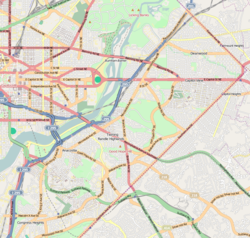History
It was designed by Snowden Ashford in 1910, and named for educator and Episcopal priest the Rev. Alexander Crummell. [3] It was built in 1911 by Allan T. Howlson, for $44,987.00. [4] It was dedicated on November 23, 1911. It was closed in 1977. A community group used the school for a preschool, library, job training and daycare center. During the 1990s, the property was used by an automobile auctioneer.
In 2012 the District government, under Mayor Vincent Gray, decided to relocate tour bus parking from Union Station to the Crummell School, paving the schoolyard, fencing-in the property, and adding pylons to protect the historic building from buses running into it. [5] Empower DC sued the DC government, and won injunctions preventing the city from actually using the historic schoolyard, dedicated to the teaching of African Americans, as a parking lot. [6] The city, blocked from using it as a tour bus parking lot, dropped the tour bus plan in 2016, instead putting an RFP out for private developers to bid on. [7]
It was listed by the D.C. Historic Preservation Review Board, on May 23, 2002. [8] It was listed on the National Register of Historic Places, in 2003. [9] The DC Preservation League placed it on its endangered list. [10]
In 2016 it was part of a redevelopment plan. [11] As of November 2020, the building is still vacant. [12]
This page is based on this
Wikipedia article Text is available under the
CC BY-SA 4.0 license; additional terms may apply.
Images, videos and audio are available under their respective licenses.



